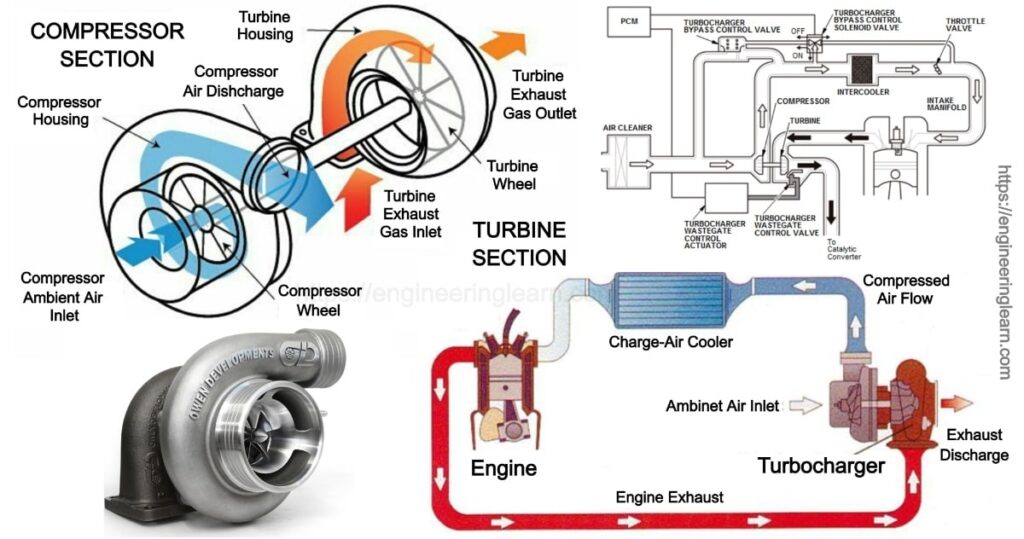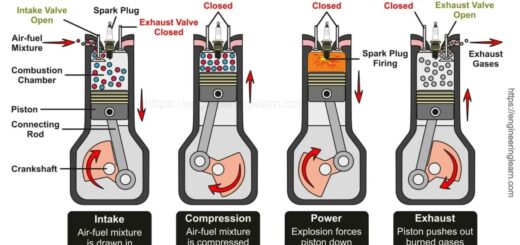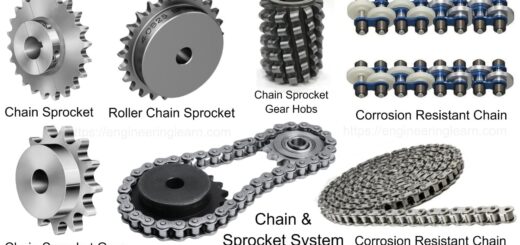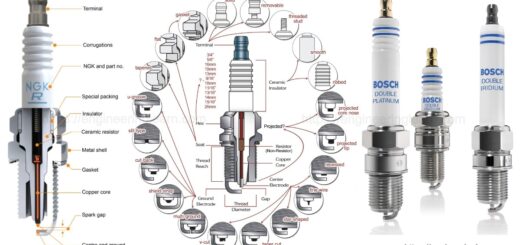What is Turbocharger Surging?

What is Turbocharger Surging? :- Turbocharger is the most vital part of the propulsion system of any ship known to mankind and turbocharger surging is a phenomenon which is responsible to affect the performance of the turbocharger directly and reduce its efficiency. [ Types of Turbocharger ]
In the turbocharger whenever there is a breakdown of gas flow taking place, a reversed scavenging of air occurs through the diffuser or the impeller blades inside the blower which leads to surging or in other words, a huge mass of oscillating airflow causes vibration of the turbo compressor impeller and its vanes. This makes the compressor unable to operate normally thus producing a very high pitch noise as a form of reaction that is also known as the compressor surge.
Turbocharger meaning
Some common terminologies like turbo surge or engine surge can also be used to describe the phenomenon well. The components involved in surging is mainly the compressor of the turbocharger and also the turbo-compressor.
It is found that the turbine or the exhaust gas side of the turbocharger does not play a vital role in the surging process directly. It can affect the performance of the complete turbocharger that can lead to the turbocharger surging undoubtedly.
If the surging continues to happen during the normal operation of the engine and the frequency of the surge engine is high then it can lead to the total damage to the bearing and in some cases it can also result in the mechanical failure of the compressor rotor.
Therefore, the turbocharger surging comprises of various engine part that do not perform in sync. It should also be kept in mind that a worn-out engine cylinder or fuel system can cause a huge problem in the engine or in the turbocharger. This can result in less airflow from the compressor against the increased back pressure, which might make the compressor surge.
So it is important to matched turbochargers properly with the engines to balance the air consumption rate and pressure across the range of the engine which is being operated and should not fall into the surge limit.
The Surge Line
It is important for the operating line of the engine to maintain sufficient volume of intake air pressure to maintain the equilibrium and high efficiency of the turbocharger.
For instance, if there is a rise in the intake of air volume, the pressure shall fall on the line of constant speed. So, in order to maintain the equilibrium or be on the operating line, the volume definitely needs to decline.
Whereas, if there is a slight decrease in volume it can result in the decreased pressure on a constant speed. So, at this stage, the compressor shall not be able to maintain the required pressure or volume which can further decrease, resulting in compressor surge.
Categories of Turbocharger Surging
1. Mild Surge
These are the surges happening under mild conditions and are not significant. These may arise due to zero flow reversal and minimum oscillations in the pressure.
2. Classic Surge
Classic surge is caused due to the low-frequency oscillations and high pressure oscillations.
3. Deep Surge
This is the most critical condition wherein the reversal of the mass flow occurs in the compressor due to which surging occurs.
Terminologies Associated with Turbocharger Surge
Surge pressure dip: The surge cycle has a particular pressure dip and the size of pressure dip will be kept sustained if the cycle continues without changing its operating point.
Surge cycle time: This refers to as the time at which the surge starts till the operating point is changed to reach equilibrium again which mean end of the engine surge.
Surge temperature behaviour: As soon as the surge takes place, there is a reversed flow of air which leads to a change in the temperature of the upstream.
Surge shaft speed variations: The shaft of the turbocharger experiences a speed change during the compressor surge which mostly contains compressor and turbine wheel.
Causes of Turbocharger Surging
Here are some of the causes of which are responsible for causing turbocharger surging:
Improper power distribution
Irregular power distribution between the main engine cylinders can mostly cause a turbocharger surging as one unit is used for producing power and the other one is used for producing less power. This leads to the air consumption required by both the turbochargers varies due to surging is caused.
Fouled turbocharger parts
- When the inlet filter of the compressor on the turbine side is found dirty, then sufficient air does not get supplied for combustion which is the root cause for surging.
- Similarly, if the nozzle, blades of the turbine side is also dirty then sufficient air cannot be produced for combustion
- Damage of silencer
- Wear and tear of turbocharger bearings
Problems in the Scavenge Air System
- Dirty air cooler and water mist catcher
- No circulation of water inside the cooler
- Jam cooling tubes
- Deposits of carbon in the scavenge ports
- High temperature of the receiver
Problems in the Exhaust System
If the system is fitted with high fouled economizer, it can cause the back pressure in the turbocharger and in a result lead to surging. Some other commonly known exhaust problems are as follows:
- Malfunctioning of the exhaust valve and improper functioning.
Problem in the Fuel System
If the fuel system does not work effectively then it can be due to some of these following problems:
- Lower circulation of pump pressure.
- Unwanted air, water in the fuel oil.
- Decreased preheating temperature of the fuel.
- Damaged fuel pump suction valve.
- Damage caused in the fuel pump plunger and valve spindle due to deposits of carbon.
- Failure of fuel valve nozzle.
- Improper load distribution system.
Some Other Affecting Factors Can Be
- Due to bad weather condition, the engine can face problems like starting to race, and this can face a sudden load change. Mostly this happens due to bad weather or pitching, the propeller moves in and out of the water, causing the load on the engine.
- Bad tuning between the engine and the turbocharger, which probably occurs in the old engines due to the isolation of one or more than one unit or even in the case of a faulty engine part.









